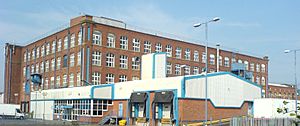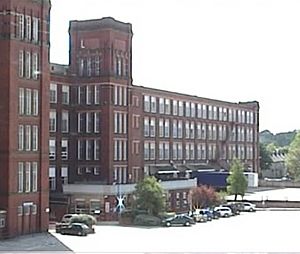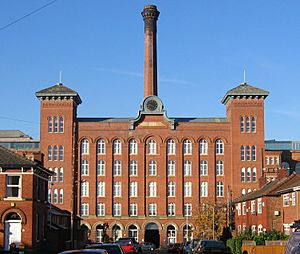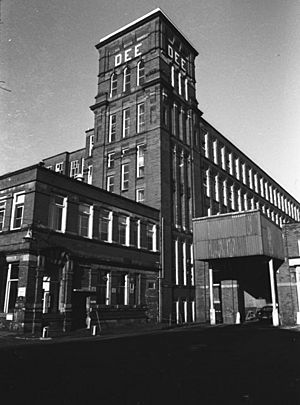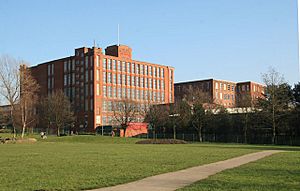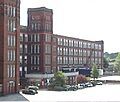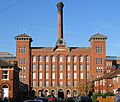Stott facts for kids
The Stott family were famous architects from Oldham, in North West England. They were of Scottish background and were experts in designing cotton mills.
James Stott was the father of the family. His sons, Joseph and Abraham Stott, both became architects but had their own separate businesses and didn't get along later in life. Their children continued their work.
Contents
The Stott Family Tree
Here's a look at the Stott family and how they were connected:
| Stott family of Oldham | |||||||||||||||||||||||||||||||||||||||||||||||||||||||||||||||||||||||||||||||||||||||||||||||||||||||||||||||||||||||||||||||||||||||||||||||||||||||||||||||||||||||||||||||||||||||||||||||||||||||||||||||||||||||||||||||||||||||||||||||||||||||||||
|---|---|---|---|---|---|---|---|---|---|---|---|---|---|---|---|---|---|---|---|---|---|---|---|---|---|---|---|---|---|---|---|---|---|---|---|---|---|---|---|---|---|---|---|---|---|---|---|---|---|---|---|---|---|---|---|---|---|---|---|---|---|---|---|---|---|---|---|---|---|---|---|---|---|---|---|---|---|---|---|---|---|---|---|---|---|---|---|---|---|---|---|---|---|---|---|---|---|---|---|---|---|---|---|---|---|---|---|---|---|---|---|---|---|---|---|---|---|---|---|---|---|---|---|---|---|---|---|---|---|---|---|---|---|---|---|---|---|---|---|---|---|---|---|---|---|---|---|---|---|---|---|---|---|---|---|---|---|---|---|---|---|---|---|---|---|---|---|---|---|---|---|---|---|---|---|---|---|---|---|---|---|---|---|---|---|---|---|---|---|---|---|---|---|---|---|---|---|---|---|---|---|---|---|---|---|---|---|---|---|---|---|---|---|---|---|---|---|---|---|---|---|---|---|---|---|---|---|---|---|---|---|---|---|---|---|---|---|---|---|---|---|---|---|---|---|---|---|---|---|---|---|
|
|||||||||||||||||||||||||||||||||||||||||||||||||||||||||||||||||||||||||||||||||||||||||||||||||||||||||||||||||||||||||||||||||||||||||||||||||||||||||||||||||||||||||||||||||||||||||||||||||||||||||||||||||||||||||||||||||||||||||||||||||||||||||||
Joseph Stott's Designs
Joseph Stott was born in Oldham on October 25, 1836. He was the third son of James Stott. Joseph became a very busy architect. He designed many buildings, especially cotton mills, in and around Oldham.
Some of his notable projects included:
- Albion Mill, Oldham (1883–1884)
- Duke Mill, Shaw (1883–1885)
- Elm Mill, Shaw (1890–1919)
- Honeywell Mill, Oldham (1874–1943)
- Lily Mills, Shaw (around 1904–1969)
- He even designed mills in other countries, like Egypt and Germany!
George Stott's Work
George Stott was Joseph Stott's only son, born in Oldham in 1876. After his father passed away in 1894, George took over the family business. He renamed it "Joseph Stott and Son" to honor his father.
George was known for using a special "triple brick arch system" for mill floors. His buildings were famous for their good looks and careful details on the outside. Two great examples are Manor Mill and Kent Mill in Chadderton. He also designed mills in places like Egypt and Brazil. George Stott died in December 1936.
Abraham Henthorn Stott, the Innovator
Abraham Henthorn Stott was born in Crompton on April 25, 1822. He learned his skills by training for seven years with Sir Charles Barry. Sir Charles Barry was a very famous architect who designed the Houses of Parliament in London.
In 1847, Abraham came back to Oldham and started his own architecture firm, "A H Stott and Sons." He was known for his clever new ideas in building design, especially for making structures strong. His brother Joseph Stott actually started his career working for Abraham before starting his own company. Later, Abraham's firm was renamed Stott and Sons. Three of his nine children also worked in the business.
Philip Sydney Stott, the Master Architect
Philip Sydney Stott, often called Sydney Stott, was Abraham Henthorn Stott's third son. Many people think he was Oldham's best architect. He started his own company, P.S. Stott, in 1883. He was known as Sydney Stott until 1920, when he was given the special title of Sir Philip Stott.
Sydney Stott used the new ideas developed by his father and another Oldham architect, Edward Potts. His first mill design was for Chadderton Mill in 1885. He designed 22 mills in Oldham and 55 more across Lancashire. His mills were a huge part of the growth of the cotton spinning industry in the area. He preferred using strong triple brick arches supported by steel beams, similar to George Stott's methods.
Besides his architecture, Stott was involved in his community. He was president of the Oldham Lyceum and played rugby for Oldham Football Club. He also held leadership roles in cotton-spinning companies. In 1913, he moved to Stanton Court in Gloucestershire. There, he became a Justice of the Peace, which means he helped keep law and order. He died in 1937.
James Stott's Business
James Stott was Abraham Henthorn Stott's younger brother. He started a different kind of business. His company focused on heating, ventilation, and kitchen equipment. Today, his company is still known as Stotts of Oldham.
Abraham Stott and Son
This company was started by a different Abraham Stott, who was a cousin of Abraham Henthorn Stott. They ran a cotton-spinning business called Osborne Mill. This Abraham Stott was known for being very fair and honest, earning him the nickname 'Honest Abe'. He once invested in a fast sailing ship called a clipper. This ship traded with the Southern states during the cotton famine, a time when cotton was scarce. However, the ship was captured by the Union forces during the American Civil War.
Images for kids


